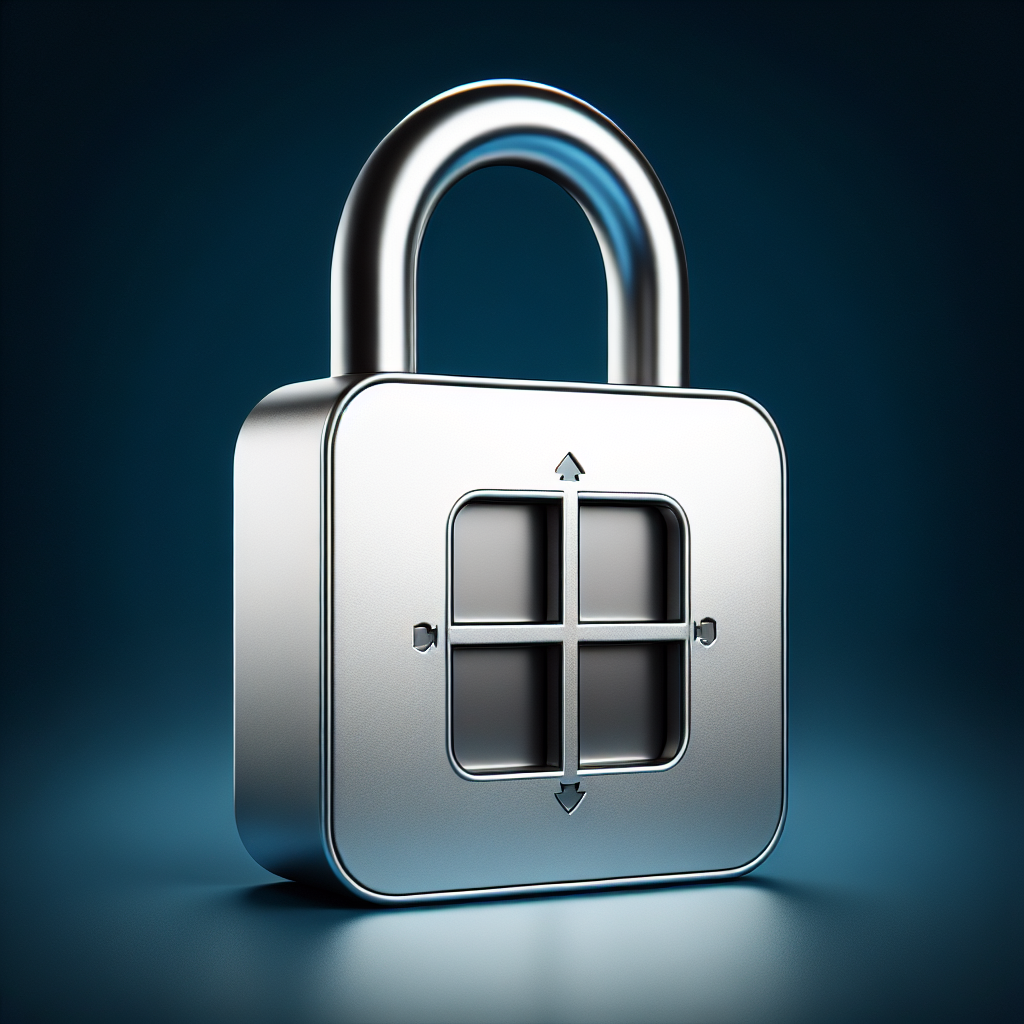Are you concerned about the security of your Windows system? Worried about the potential threat of malware? Look no further! In this article, we will explore various steps you can take to keep your Windows system safe and secure from malicious software. By following these simple guidelines, you can ensure the protection of your valuable personal information and enjoy a worry-free computing experience.

Install a Reliable Antivirus Program
One of the most important steps you can take to keep your Windows system secure from malware is to install a reliable antivirus program. With the constant threat of viruses, worms, and other malicious software, having robust antivirus protection is crucial.
Research Different Antivirus Programs
Before you make a decision, it’s vital to research and compare different antivirus programs. There are numerous options available in the market, each with their own unique features and capabilities. Consider factors such as detection rates, system resource usage, ease of use, and compatibility with your operating system.
Choose a Well-known and Trusted Antivirus Software
When selecting an antivirus program, it’s important to go for a well-known and trusted software. Established antivirus providers have a reputation to uphold and invest heavily in research and development to combat emerging threats. Look for antivirus software that receives regular updates and has a strong track record of detecting and removing malware.
Ensure Automatic Updates Are Enabled
Once you have installed an antivirus program, it’s crucial to ensure that automatic updates are enabled. Regular updates are essential to stay protected against the latest malware threats. Antivirus software providers regularly release updates to enhance their detection capabilities and address any vulnerabilities. By enabling automatic updates, you can ensure that your antivirus program is always up to date and ready to defend your system.
Keep Your Operating System Up to Date
Another important step in keeping your Windows system secure from malware is to keep your operating system up to date. This includes enabling automatic updates and regularly checking for updates.
Enable Automatic Windows Updates
To ensure that your operating system remains protected against the latest security threats, it’s crucial to enable automatic Windows updates. Windows updates not only include new features and improvements but also important security patches. Microsoft regularly releases updates to address vulnerabilities that could be exploited by malware. By enabling automatic updates, you can ensure that your system receives these critical updates promptly.
Regularly Check for Updates
In addition to enabling automatic updates, it’s a good practice to manually check for updates regularly. Sometimes, updates may not be installed automatically due to specific settings or network issues. By manually checking for updates, you can ensure that your system is up to date and secure.
Install Critical Security Patches
When installing updates, pay special attention to critical security patches. These patches address known vulnerabilities in the operating system that could be exploited by malware. It’s essential to install these patches as soon as they become available to protect your system from potential threats.

Enable Firewall Protection
To add an additional layer of security to your Windows system, it’s important to enable firewall protection. Firewalls act as a barrier between your computer and the outside world, monitoring and controlling the network traffic to and from your system.
Activate the Built-in Windows Firewall
Windows comes with a built-in firewall that provides basic protection for your system. It’s important to ensure that the Windows Firewall is activated and properly configured. By default, the Windows Firewall is usually enabled, but it’s worth double-checking to ensure that it hasn’t been accidentally disabled.
Consider Using a Third-party Firewall Software
While the built-in Windows Firewall offers a baseline level of protection, you may also consider using a third-party firewall software for enhanced security. Third-party firewalls often provide advanced features such as intrusion detection and prevention, application-level filtering, and more granular control over network traffic. Make sure to choose a reputable firewall software and configure it to fit your system’s specific security needs.
Be Cautious When Installing Software
When it comes to installing software on your Windows system, exercising caution is crucial. Careless installation can inadvertently introduce malware onto your system. Follow these steps to reduce the risk:
Download Software from Trusted Sources
When downloading software, it’s essential to only source it from trusted and reputable websites. Avoid downloading software from unfamiliar or suspicious sources, as they may contain malware or bundled adware. Stick to official websites, reputable software marketplaces, or trusted download portals.
Read User Reviews and Ratings
Before installing software, take the time to read user reviews and ratings. This feedback can provide valuable insights into the legitimacy and safety of the software. Look out for any red flags such as reports of malware or excessive advertising. If a software has overwhelmingly negative reviews, it’s best to steer clear from it.
Avoid Installing Unnecessary Software
To minimize the risk of introducing malware onto your system, avoid installing unnecessary software. Only install programs that you truly need and ensure that the software comes from a trusted source. Uninstall any programs that you no longer use, as they can potentially become vulnerability points for malware.

Exercise Safe Browsing Habits
Practicing safe browsing habits is essential to protect your Windows system from malware. By following these guidelines, you can reduce the risk of encountering malicious websites or downloading infected files.
Use a Secure Web Browser
Choose a secure web browser that prioritizes user security and privacy. Popular options such as Google Chrome, Mozilla Firefox, and Microsoft Edge have built-in security features and regular updates to protect against the latest web-based threats. Keep your chosen browser up to date by installing updates as soon as they become available.
Keep Browsers and Plugins Updated
To ensure maximum security, it’s important to keep both your web browser and its accompanying plugins up to date. Browsers and plugins often receive updates that address security vulnerabilities and implement improved protection mechanisms. Enable automatic updates for your browser and plugins to ensure they are always running the latest versions.
Avoid Clicking on Suspicious Links or Pop-ups
Exercise caution when clicking on links or pop-ups, especially from unfamiliar or suspicious sources. Malicious websites and pop-ups can attempt to trick you into downloading malware or providing sensitive information. If a link or pop-up seems suspicious, it’s best to err on the side of caution and avoid clicking on it. Be especially wary of emails or messages from unknown senders that contain links.
Use Complex and Unique Passwords
Using strong, complex, and unique passwords is an essential step in securing your Windows system. With the increasing sophistication of password-cracking techniques, it’s important to implement robust password practices to prevent unauthorized access to your accounts.
Create Strong Passwords
When creating passwords, ensure they are strong and difficult to crack. A strong password typically includes a combination of upper and lowercase letters, numbers, and special characters. Avoid using predictable patterns or easily guessable information, such as birthdays or names. Instead, consider using a mix of unrelated words or a passphrase that is memorable to you but not easily guessable.
Avoid Using the Same Password for Multiple Accounts
Using the same password for multiple accounts can leave you vulnerable to a domino effect if one account gets compromised. It’s important to use unique passwords for each of your accounts, especially for critical ones such as email, banking, or social media accounts. If remembering multiple passwords becomes challenging, consider using a password manager.
Consider Using a Password Manager
A password manager is a software tool that securely stores and manages your passwords. Password managers can generate complex passwords, remember them for you, and automatically fill them in when needed. This eliminates the need to remember multiple passwords while ensuring each account has a unique and strong password. Look for reputable password managers with robust encryption and authentication features.
Regularly Backup Your Data
Backing up your data is crucial to protect against data loss caused by malware or other unexpected events. In the event of a malware infection or system failure, having up-to-date backups ensures that you can restore your important files and minimize potential disruptions.
Choose an External Storage Device or Cloud Service
Select a reliable external storage device or cloud service to store your backups. External hard drives, USB flash drives, or network-attached storage (NAS) devices offer physical storage options that you can easily disconnect from your system. Alternatively, cloud services such as Google Drive, Dropbox, or Microsoft OneDrive provide secure online storage options accessible from anywhere with an internet connection.
Automate Backup Processes
To ensure that your backups are always up to date, automate the backup process whenever possible. Most operating systems and backup software offer built-in scheduling options to set up regular automated backups. Schedule backups to occur when your computer is not in use or during periods of low activity to minimize potential interruptions.
Test Data Restoration
Regularly test the restoration process to verify the integrity of your backups. Perform test restores on a separate device or in a controlled environment to ensure that your backups are indeed recoverable. This step helps identify any issues or gaps in your backup strategy and allows you to address them proactively.
Educate Yourself and Your Users
Keeping yourself and your users informed about the latest malware threats and safe computing practices is crucial in maintaining a secure Windows system. By educating yourself and others, you can mitigate the risks associated with malware infections.
Stay Informed About Latest Malware Threats
Stay updated on the latest malware threats, attack techniques, and security best practices. Follow reputable technology news websites, security blogs, and official advisories to stay informed about emerging threats. This knowledge allows you to recognize potential risks and take appropriate preventive measures to protect your system.
Train Users on Safe Computing Practices
If you have other users, such as family members or coworkers, who share the same Windows system, it’s important to educate them on safe computing practices. Train them to recognize suspicious emails, avoid downloading files from untrusted sources, and use strong passwords. Encourage them to report any unusual or potentially malicious activities to you.
Be Wary of Social Engineering Techniques
Social engineering techniques aim to trick individuals into divulging sensitive information or performing actions that can compromise their security. Educate yourself and your users about common social engineering techniques, such as phishing emails, deceptive websites, or phone scams. By raising awareness, you can reduce the risk of falling victim to these tactics.
Secure Your Wi-Fi Network
Securing your Wi-Fi network is essential to prevent unauthorized access to your Windows system and protect your data. By implementing the following measures, you can enhance your network’s security.
Change Default Credentials for Your Router
Whenever you set up a new Wi-Fi router, it typically comes with default login credentials. It’s crucial to change these default credentials immediately. Default credentials are widely known and easily exploitable by attackers. By setting unique and strong passwords for your router’s administration interface, you can significantly reduce the risk of unauthorized access.
Enable Network Encryption
Encrypting your Wi-Fi network adds an extra layer of security by protecting the data transmitted between your devices and the router. Ensure that your Wi-Fi network is using WPA2 (or WPA3) encryption, as it is the most secure option currently available. Avoid using WEP (Wired Equivalent Privacy) or older encryption protocols, as they are susceptible to attacks.
Disable Remote Access to Your Router
To further secure your Wi-Fi network, disable remote access to your router’s administration interface. Remote access allows someone outside of your network to potentially control and manipulate your router’s settings. By disabling remote access, you minimize the risk of unauthorized individuals gaining control over your network.
Regularly Scan Your System for Malware
Regularly scanning your system for malware is an essential part of maintaining a secure Windows environment. By performing thorough scans using antivirus software, you can detect and remove any potential threats.
Perform Full System Scans
Performing full system scans periodically is recommended to thoroughly inspect all files and processes on your Windows system. Schedule regular full scans that occur during periods of low activity or overnight to minimize any impact on system performance. Full scans are comprehensive and ensure that no malware or suspicious files go undetected.
Use an On-demand Scanner for Manual Scans
In addition to full system scans, it’s also beneficial to use on-demand scanners for manual scans. On-demand scanners allow you to scan specific files, folders, or drives whenever you suspect malware presence. If you encounter any suspicious files or notice unusual system behavior, use an on-demand scanner to investigate further.
Remove Detected Malware Appropriately
If malware is detected during scans, it’s essential to remove it promptly and appropriately. Most antivirus programs offer quarantine or removal options for identified threats. Quarantine isolates the suspicious files, preventing them from causing further harm, while removal permanently deletes them from your system. Follow the instructions provided by your antivirus software to safely and effectively remove any detected malware.
By following these comprehensive steps, you can significantly improve the security of your Windows system and better protect it from malware threats. Remember to regularly update your antivirus software, operating system, and other software components to stay ahead of emerging threats. Practice safe browsing habits, exercise caution when downloading and installing software, and educate yourself and your users on best security practices. By implementing these measures, you can create a more secure computing environment and minimize the risk of malware infections.
